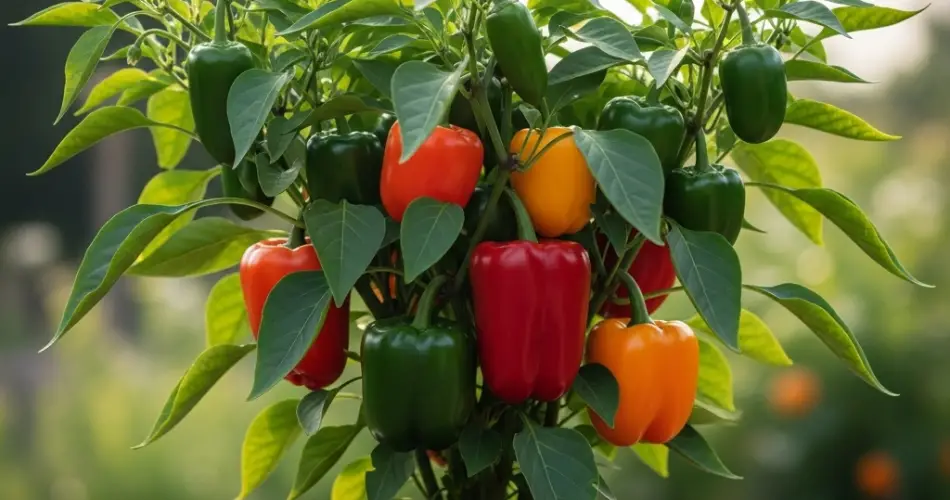Don’t let limited space hold you back from growing a productive and colorful pepper garden. Whether you prefer sweet bell peppers or fiery chili varieties, you can enjoy a bountiful harvest right from compact containers. Container gardening for peppers is not only space-efficient, but it also offers greater control over soil, watering, and sunlight, resulting in healthier plants and better yields.
Perfect for balconies, patios, rooftops, and small courtyards, growing peppers in containers allows even urban dwellers to enjoy homegrown, flavorful vegetables with minimal effort.
Why Grow Peppers in Containers?
Peppers are one of the best crops for small-space gardening. Here’s why they thrive in containers:
-
Sun lovers: Peppers love heat and sun. You can move pots around to maximize light exposure.
-
Controlled soil: Growing in pots avoids issues with poor garden soil and helps manage pH and nutrients.
-
Easier pest control: Container plants are easier to monitor and protect from pests and diseases.
-
Decorative and functional: Many pepper varieties are both attractive and edible, brightening up your space.
With the right container and basic care, you can enjoy fresh peppers from your own mini garden.
Choosing the Right Container
Peppers need room for roots to spread and adequate drainage to avoid root rot. Here’s what to look for:
-
Size: At least 3–5 gallons (about 12 inches deep and wide). Larger containers support larger plants and higher yields.
-
Material: Plastic, clay, fabric grow bags, or recycled buckets all work, as long as drainage holes are present.
-
Drainage: Always ensure your pot allows excess water to escape to prevent soggy soil and disease.
Dark-colored containers retain warmth, which peppers love, but in very hot climates, light-colored pots may prevent overheating.
Ideal Soil and Fertilizer
Use a lightweight potting mix rather than garden soil, which can be heavy and may retain too much moisture.
Recommended mix:
-
2 parts quality potting soil
-
1 part compost
-
Optional: 1 part coco coir or perlite for aeration
Before planting, mix in a slow-release organic fertilizer or balanced vegetable fertilizer (such as 10-10-10). Throughout the season, you can boost growth with diluted liquid fertilizer or compost tea every two to three weeks, especially when fruit starts forming.
Selecting Pepper Varieties
Most pepper types adapt well to container growing, but some varieties are better suited for compact spaces. Consider these:
-
Bell Peppers: Mini bell varieties like ‘Baby Belle’ or ‘Lunchbox’ are great for pots.
-
Chili Peppers: ‘Cayenne,’ ‘Jalapeño,’ ‘Thai chili,’ and ‘Bird’s Eye’ peppers thrive in containers.
-
Sweet Peppers: Look for compact varieties like ‘Yum Yum’ or ‘Mini Sweet.’
Dwarf and bush-type varieties tend to perform best in containers due to their smaller size and compact growth habits.
How to Plant Peppers in Pots
-
Choose healthy seedlings or start seeds indoors 6–8 weeks before the last frost.
-
Fill the container with the prepared soil mix, leaving about 2 inches from the top.
-
Transplant one pepper seedling per pot, placing it at the same depth it was growing in the nursery pot.
-
Water thoroughly to help the roots settle.
Keep the pots in a spot that receives at least 6–8 hours of full sunlight daily. Peppers are sun-loving and heat-tolerant, making a sunny balcony or patio ideal.
Caring for Container-Grown Peppers
-
Watering: Water when the top inch of soil feels dry. Containers dry out faster than ground soil, especially in hot weather.
-
Support: Use a small stake or tomato cage to support the plant once it starts bearing fruit.
-
Pruning: Remove the first few flowers to encourage the plant to focus on root and leaf development early on.
-
Pest Monitoring: Watch for aphids, whiteflies, and spider mites. Remove pests manually or treat with organic insecticidal soap if needed.
Mulching the top of the soil with straw or dry leaves can help retain moisture and regulate temperature.
Harvesting Your Peppers
Peppers are usually ready for harvest 60–90 days after transplanting, depending on the variety. You can pick them green or wait until they ripen to red, yellow, or orange for a sweeter taste.
Use scissors or garden shears to cut the peppers cleanly from the stem to avoid damaging the plant. Regular harvesting encourages more blooms and fruit development.
Tips for Bigger Yields
-
Don’t overcrowd: One pepper plant per container ensures healthy growth.
-
Rotate containers: If sunlight is uneven, turn the pots every few days to ensure even growth.
-
Keep warm: Peppers love warmth. Avoid exposing them to temperatures below 15°C (59°F).
-
Pollinate: In indoor or sheltered areas, gently shake the flowers or use a small brush to mimic natural pollination.
Conclusion
Even with limited space, you can enjoy a satisfying pepper harvest using compact containers. With the right variety, good soil, and a sunny location, container-grown peppers will reward you with colorful fruits and abundant flavor. Whether you’re growing sweet bells or spicy chilies, container gardening makes fresh, homegrown peppers accessible to anyone—no backyard required.



